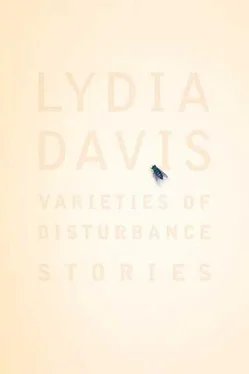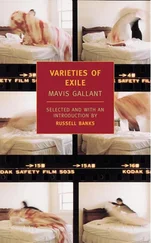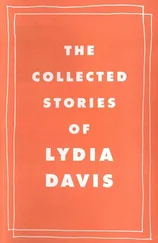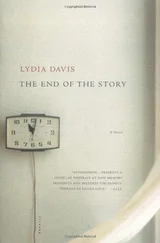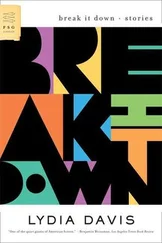I go back to my work. Then I begin to forget the caterpillar. I forget him for as long as one hour, until I happen to go to the stairs again. This time I see that there is something just the right size, shape, and color on one of the steps. But it is flat and dry. It can’t have started out as him. It must be a short pine needle or some other plant part.
The next time I think of him, I see that I have forgotten him for several hours. I think of him only when I go up or down the stairs. After all, he is really there somewhere, trying to find his way to a green leaf, or dying. But already I don’t care as much. Soon, I’m sure, I will forget him entirely.
Later there is an unpleasant animal smell lingering about the stairwell, but it can’t be him. He is too small to have any smell. He has probably died by now. He is simply too small, really, for me to go on thinking about him.
It’s his turn to take care of the baby. He is cross.
He says, “I never get enough done.”
The baby is in a bad mood, too.
He gives the baby a bottle of juice and sits him well back in a big armchair.
He sits himself down in another chair and turns on the television.
Together they watch The Odd Couple.
We Miss You: A Study of Get-Well Letters from a Class of Fourth-Graders
The following is a study of twenty-seven get-well letters written by a class of fourth-graders to their classmate Stephen, when he was in the hospital recovering from a serious case of osteomyelitis.
The disease set in after a rather mysterious accident involving a car. Young Stephen, according to his own later report and a brief notice in the local newspaper, was returning home by himself at dusk one day in early December. He stepped into the street, preparing to cross, and was hit obliquely by a slow-moving car, not with great force, but with enough force to knock him to the ground. The driver of the car, a man of indeterminate age, stopped and got out to see if the boy was all right. Ascertaining that no great harm had been done, the man drove on. In fact, the boy had hurt his knee but said nothing about the accident at home, out of embarrassment or a perception that he was somehow to blame. The knee, untreated, became infected; the osteomyelitis bacteria entering the wound; the boy became seriously ill and was hospitalized. After some weeks, and worry on the part of his doctors, family, and friends, he recovered, thanks in part to the recently developed drug penicillin, and was discharged.
At the time of Stephen’s hospitalization, his parents put the following notice in the local paper in an attempt to locate the driver of the car. The notice was headlined PARENTS SEEK TO TALK TO DRIVER OF CAR IN ACCIDENT. It read:
About the first week of December, Stephen, son of Mr. and Mrs. B. of 94 N. Rd., at the corner of Elm and Crescent Streets in the late afternoon, was struck very lightly by a car whose driver got out and looked the boy over and discussed it with him. Then each went on his way.
The parents of the boy would like to get in touch with the driver of the vehicle and are appealing to him to communicate with them.
There was no response to the notice.
After the Christmas holidays were over and his classmates returned to school, the children’s teacher, Miss F., assigned them to write Stephen a get-well letter. She then corrected the letters sparingly but precisely and sent them in a packet to Stephen. This was a school exercise clearly intended, if we may judge from the number of consistent features, to teach certain letter-writing skills.
The School
The school in which these letters were written was a large brick building dedicated to use by classes from kindergarten through eighth grade and situated in the heart of a pleasant residential neighborhood. The streets were lined with mature shade trees, and the houses were for the most part roomy and comfortable but unostentatious middle-class homes with modest or, occasionally, generous yards planted with lawns and a variety of trees, shrubs, and flowers. Most of the children lived in the immediate neighborhood of the school and walked to and from school by themselves or with friends on sidewalks that were well maintained but here and there cracked or buckled by the roots of the large trees. Stephen himself, along with his neighbors Carol and Jonathan, lived one street over from the school. At the corner of the street on which the school stood was a small store owned and presided over by a matronly woman with a rather forbidding manner. It sold candy and a limited range of groceries, and was heavily patronized by the children after school. Across from this store, a street descended steeply toward a broad, shallow river in which the children were not allowed to swim because of effluents from the factories upstream. The school building was surrounded by a large asphalt playground lacking climbing or swinging equipment. The classrooms were well lighted, with natural daylight coming in through large windows.
General Appearance and Form of the Letters
The letters are written on lined exercise paper of two different sizes, most of them on the smaller, 7? by 8 ½? four of them on the larger, 8? by 10 ½?. Although the paper is of a low grade and was manufactured nearly sixty years ago, it has remained supple and smooth in texture, and the letters are still clearly legible, some students in particular having borne down heavily to make very dark and distinct lines. They are all written in ink, though the ink varies, some blue and some black, some dark and some light, some lines thin and some thick.
The penmanship is for the most part quite good, i.e., the script slopes at a fairly consistent angle to the right, most letters touch the line, the letters are evenly spaced, the uprights of the letters do not touch the line above, etc., though the variations in thickness of line and formation of letters, as well as the wavering lines, betray the tremulous hands and labored efforts of the novice script-users. Some of the capitals, however, are very elegantly formed, with a handsome flourish.
There are twenty-seven letters altogether, written by thirteen girls and fourteen boys. Twenty-four of the children’s letters are dated January 4, evidently the day on which the teacher set them to work as a group; two are dated January 5, and one January 8, implying that these children were absent on the day the exercise was initiated.
The letters all carry the same heading, obviously prescribed by the teacher, on three lines in the upper-right-hand corner: the name of the school; the town and state; and the date. They are ruled by hand in pencil down the left margin to provide a uniform indented guide for the beginning of each line, with the exception of the January 8 letter — this latecomer evidently was not given the instruction or did not hear it — and those written on the larger sheets of paper, which bear a printed rule down the left margin. The hand-ruled lines vary: some are thin and straight, others thick and slanted, and one trails off at an angle at the bottom, the pupil having evidently reached the end of his ruler before he reached the bottom of the page.
The salutations are all the same: “Dear Stephen.” The closings vary within a narrow range: “Your friend” (5 boys and 10 girls); “Your classmate” (3 girls and 2 boys); “Your pal” (4 boys); “Sincerely yours” (1 boy); “Love” (1 boy); and “Your pal of pals” (1 boy: this was Jonathan, a close friend). It should be noted that only the boys use the colloquial “pal,” whereas nearly twice as many girls as boys use the more formal “friend.”
The teacher has inked in corrections on some of the letters, in the darkest ink and a smaller hand. She has added commas where missing (most frequently after the salutation, “Dear Stephen,” the closing, e.g. “Your friend,” and between the name of the town and the state) and question marks where required. She has corrected some misspellings (“happey,” “sleding,” “throught,” “brouther,” and “We are mississ you very much”). In one case she has, surprisingly, had to correct the spelling of a child’s name, reducing “Arilene” to “Arlene.” She has supplied two missing words. Several errors have escaped her notice. On the whole, the letters are spelled and punctuated correctly; the teacher makes, on average, only about one correction per page, and most of these are punctuation corrections. Either the students have learned their lessons very well or, perhaps more likely, these are fair copies of rough, corrected drafts.
Читать дальше
